1. Baratham G, Dennyson WG. Delayed traumatic intracerebral haemorrhage. J Neurol Neurosurg Psychiatry. 1972; 35:698–706. PMID:
5084138.

2. Blount JP, Campbell JA, Haines SJ. Complications in ventricular cerebrospinal fluid shunting. Neurosurg Clin N Am. 1993; 4:633–656. PMID:
8241787.

3. Bondurant CP, Jimenez DF. Epidemiology of cerebrospinal fluid shunting. Pediatr Neurosurg. 1995; 23:254–258. PMID:
8688350.

4. Choux M, Genitori L, Lang D, Lena G. Shunt implantation: reducing the incidence of shunt infection. J Neurosurg. 1992; 77:875–880. PMID:
1432129.

5. Derdeyn CP, Delashaw JB, Broaddus WC, Jane JA. Detection of shunt-induced intracerebral hemorrhage by postoperative skull films: a report of two cases. Neurosurgery. 1988; 22:755–757. PMID:
3374789.

6. Evans JP, Scheinker IM. Histologic studies of the brain following head trauma; post-traumatic petechial and massive intracerebral hemorrhage. J Neurosurg. 1946; 3:101–113. PMID:
21018500.
7. Fujioka S, Matsukado Y, Kaku M, Yano T, Yoshioka S. Delayed apoplexy following ventricular puncture-a case report. No Shinkei Geka. 1982; 10:955–958. PMID:
6983661.
8. Fukamachi A, Koizumi H, Nukui H. Postoperative intracerebral hemorrhages: a survey of computed tomographic findings after 1074 intracranial operations. Surg Neurol. 1985; 23:575–580. PMID:
3992457.

9. Goodnight SH Jr. Bleeding and intravascular clotting in malignancy: a review. Ann N Y Acad Sci. 1974; 230:271–288. PMID:
4522874.

10. Keimowitz RM, Annis BL. Disseminated intravascular coagulation associated with massive brain injury. J Neurosurg. 1973; 39:178–180. PMID:
4719695.

11. Kothari RU, Brott T, Broderick JP, Barsan WG, Sauerbeck LR, Zuccarello M, et al. The ABCs of measuring intracerebral hemorrhage volumes. Stroke. 1996; 27:1304–1305. PMID:
8711791.

12. Mant MJ, King EG. Severe, acute disseminated intravascular coagulation. A reappraisal of its pathophysiology, clinical significance and therapy based on 47 patients. Am J Med. 1979; 67:557–563. PMID:
495626.
13. McGauley JL, Miller CA, Penner JA. Diagnosis and treatment of diffuse intravascular coagulation following cerebral trauma. Case report. J Neurosurg. 1975; 43:374–376. PMID:
1151476.
14. Misaki K, Uchiyama N, Hayashi Y, Hamada J. Intracerebral hemorrhage secondary to ventriculoperitoneal shunt insertion--four case reports. Neurol Med Chir (Tokyo). 2010; 50:76–79. PMID:
20098034.
15. Oertel M, Kelly DF, McArthur D, Boscardin WJ, Glenn TC, Lee JH, et al. Progressive hemorrhage after head trauma: predictors and consequences of the evolving injury. J Neurosurg. 2002; 96:109–116. PMID:
11794591.

16. Palmieri A, Pasquini U, Menichelli F, Salvolini U. Cerebral damage following ventricular shunt for infantile hydrocephalus evaluated by computed tomography. Neuroradiology. 1981; 21:33–35. PMID:
7219699.

17. Pennlert J, Eriksson M, Carlberg B, Wiklund PG. Long-term risk and predictors of recurrent stroke beyond the acute phase. Stroke. 2014; 45:1839–1841. PMID:
24788972.

18. Savitz MH, Bobroff LM. Low incidence of delayed intracerebral hemorrhage secondary to ventriculoperitoneal shunt insertion. J Neurosurg. 1999; 91:32–34. PMID:
10389877.

19. Sayers MP. Shunt complications. Clin Neurosurg. 1976; 23:393–400. PMID:
975690.

20. Shurin S, Rekate H. Disseminated intravascular coagulation as a complication of ventricular catheter placement. Case report. J Neurosurg. 1981; 54:264–267. PMID:
7452342.
21. Smith DR, Ducker TB, Kempe LG. Experimental in vivo microcirculatory dynamics in brain trauma. J Neurosurg. 1969; 30:664–672. PMID:
4977840.

22. Snow RB, Zimmerman RD, Devinsky O. Delayed intracerebral hemorrhage after ventriculoperitoneal shunting. Neurosurgery. 1986; 19:305–307. PMID:
3489202.

23. Stein SC, Young GS, Talucci RC, Greenbaum BH, Ross SE. Delayed brain injury after head trauma: significance of coagulopathy. Neurosurgery. 1992; 30:160–165. PMID:
1545882.
24. Touho H, Hirakawa K, Hino A, Karasawa J, Ohno Y. Relationship between abnormalities of coagulation and fibrinolysis and postoperative intracranial hemorrhage in head injury. Neurosurgery. 1986; 19:523–531. PMID:
3785592.

25. Udvarhelyi GB, Wood JH, James AE Jr, Bartelt D. Results and complications in 55 shunted patients with normal pressure hydrocephalus. Surg Neurol. 1975; 3:271–275. PMID:
1154252.
26. Wu Y, Green NL, Wrensch MR, Zhao S, Gupta N. Ventriculoperitoneal shunt complications in California: 1990 to 2000. Neurosurgery. 2007; 61:557–562. PMID:
17881969.
27. Zia E, Engström G, Svensson PJ, Norrving B, Pessah-Rasmussen H. Three-year survival and stroke recurrence rates in patients with primary intracerebral hemorrhage. Stroke. 2009; 40:3567–3573. PMID:
19729603.

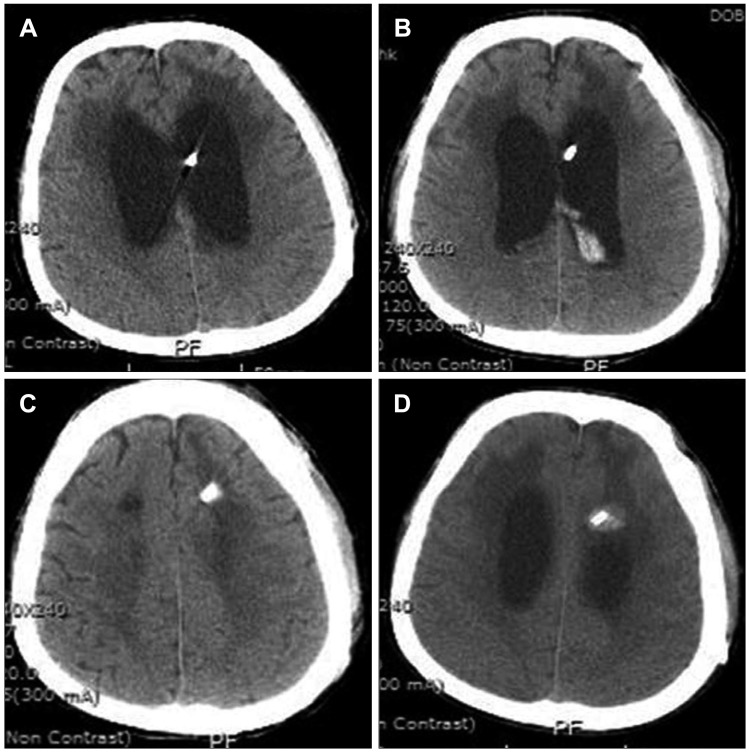




 PDF
PDF ePub
ePub Citation
Citation Print
Print


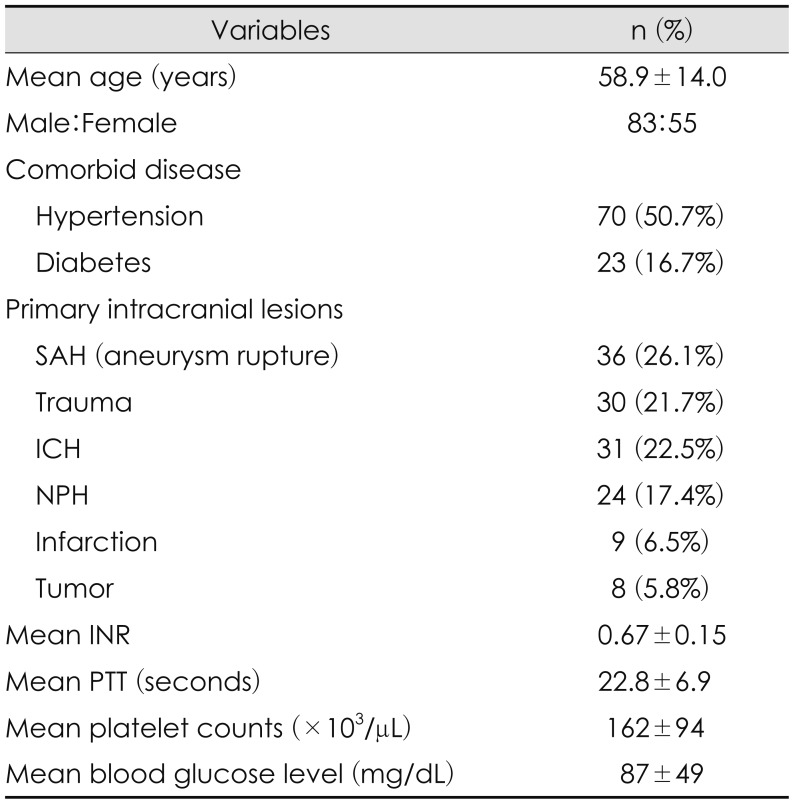
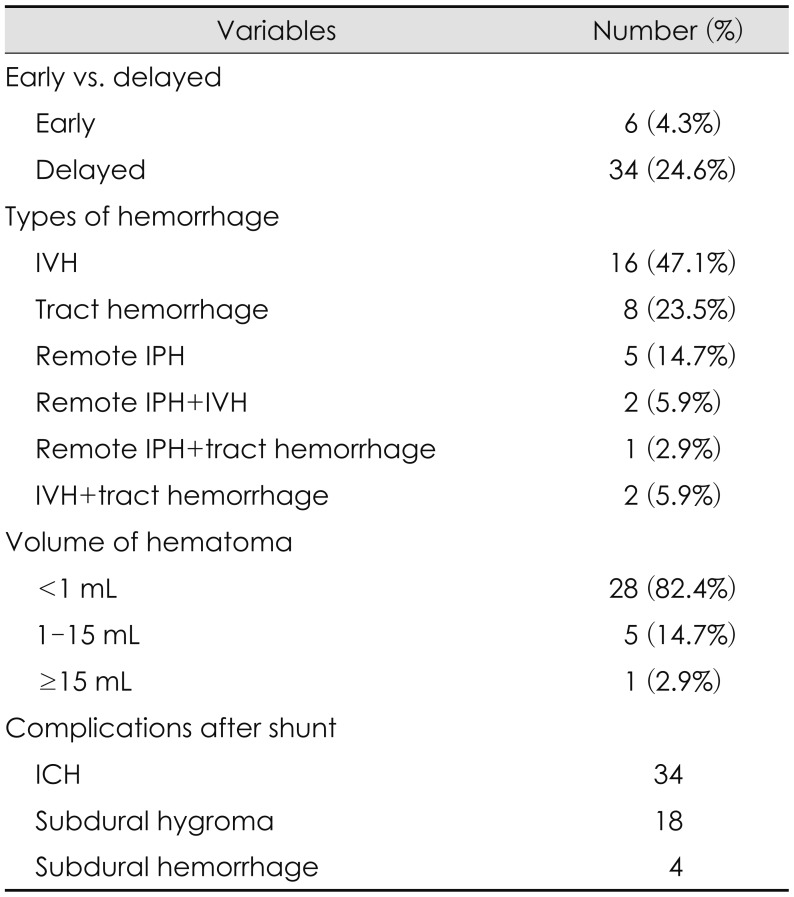
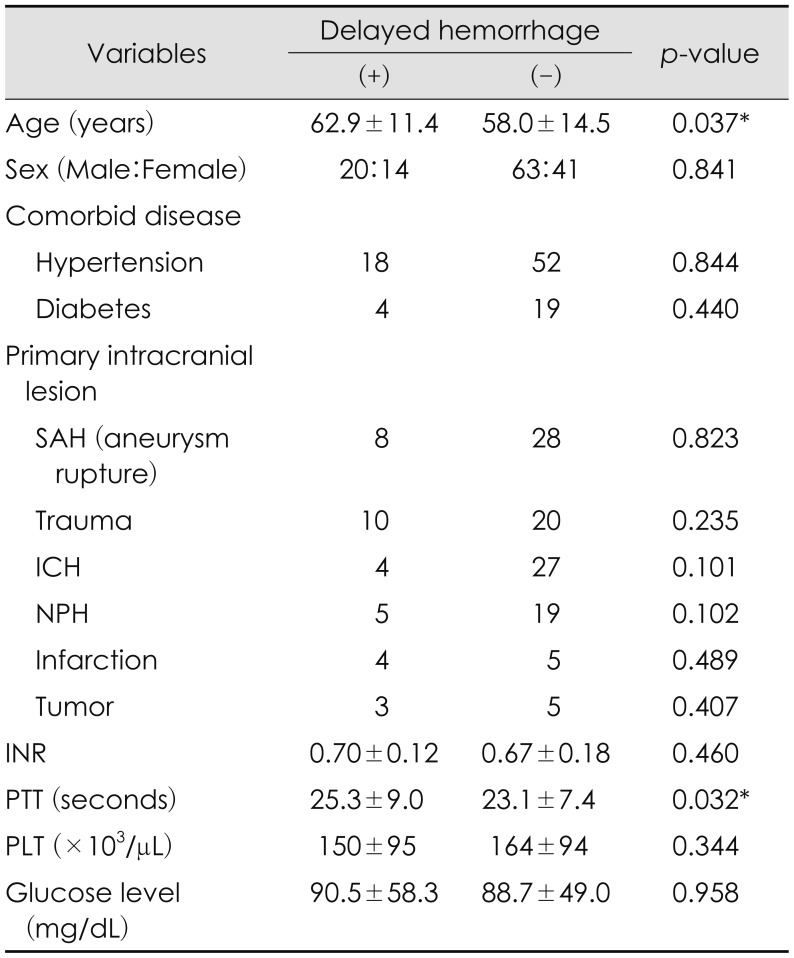
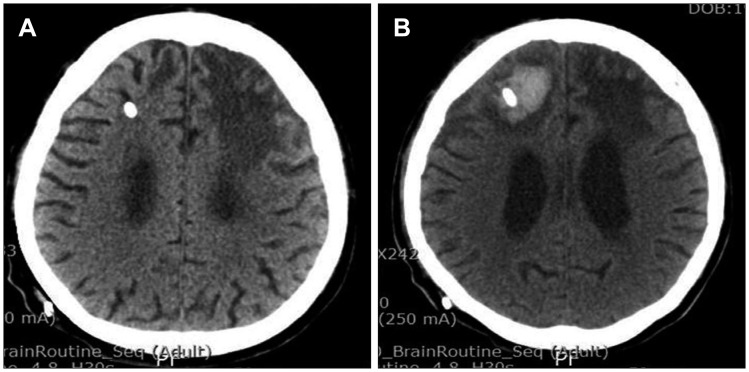
 XML Download
XML Download